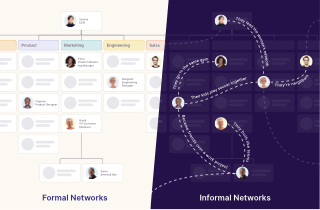It’s Time to Invest In Your Employee Networks

Informal networks exist at your org whether you invest in, strengthen, or even acknowledge them. Now that remote work is the norm, informal networks are even more important—they’re how people feel connected, engaged, and see opportunities for themselves to remain at and advance within your organization
What do we mean by employee network?
Simply put, an employee network is a metaphor for all the connections that exist between coworkers that enable an organization to work effectively. Employee networks can be both formal and informal. One obvious example of a formal network is the org chart—a visual representation of the structure of your company that reveals roles, responsibilities, and relationships as designed by the company’s leadership.
Additionally, many orgs—maybe even yours—have other formal networks, often referred to as employee resource groups (ERGs) where employees decide to join a cohort of other like-minded or similarly diverse individuals to encourage personal growth and help make the world outside their (home) office a better place. It could be a network of those intent on healing the environment, standing up for racial injustice, or advocating for gender equality. Check out Nike’s eight company-sanctioned employee networks for a great example of ERGs.
While formal employee networks are the result of deliberate decisions by org leaders (ie the org chart) or at least with buy-in from leadership (like ERGs), informal networks can’t help but exist. In their seminal (and old—1993!) piece on network analysis, Krackhardt and Hanson explain informal networks like this: “If the formal organization is the skeleton of a company, the informal is the central nervous system driving the collective thought processes, actions, and reactions of its business units.”

Informal networks exist at your company—whether you invest in, strengthen, build on…or even acknowledge them. There are no visuals or regularly scheduled check-ins for informal networks. An informal network is of the “watercooler” variety—in the pre-pandemic days, it might look like a casual group conversation about last night’s Game of Thrones episode, developers talking about the latest Ruby release, or a happy-hour meetup of other young parents who are trying to juggle it all. Usually, an informal network covers the ground between coworkers-you-want-to-be-around and friends forever. They needn’t be in the same department, or even on the same floor, but Kelly in Design and Krishna in Operations love the same bands and, when they aren’t talking about a surprise album release on Spotify last night, they’re exchanging advice on things like managing upwards or giving a coworker tough feedback.
Why Employee Networks are Crucial Now
The first pandemic in more than a century has forced us to change how we work, maybe forever. For the knowledge economy (where information is capital, rather than physical products), remote work is the new norm. And for companies whose people must return to the office, social distancing and other in-office pandemic protocol has kept people apart. Critical in-person interactions are reduced to impersonal shorthand exchanges, a small box on a Zoom call, or misspelled words in a text message. Individuals begin to lose that personal chemistry, as well as the opportunity to forge new relationships, and therefore so much about what made the job special. It wasn’t just about the work; it was about the workers, too. Individuals, groups, and teams feel disconnected at best and demoralized at worst.
If Krishna in Ops gets laid off, Kelly in Design might mentally check out. And if Kelly is a “linchpin” at your org—someone who connects other networks and plays such a critical role in the flow of information “that their departure would disrupt the network,” according to McKinsey—it could be disastrous. Imagine this at scale, across your company.
Beyond individual and group dynamics, these changes are affecting your organization’s productivity and success. A 2007 McKinsey analysis of how information flows through a company found that informal networks at a company are the main way information flows and work gets done, not the formal structures organized by the org chart. Why? Here’s their hypothesis:
“Designed to facilitate standard modes of production, the formal organization is set up to handle easily anticipated problems. But when unexpected problems arise, the informal organization kicks in. Its complex webs of social ties form every time colleagues communicate and solidify over time into surprisingly stable networks. Highly adaptive, informal networks move diagonally and elliptically, skipping entire functions to get work done.”
In a turn of phrase: informal networks are the lifeblood of your company. And maintaining, investing in, and strengthening these networks is critical because connectedness affects employee retention and productivity, and that’s no more critical than right now, in these tough times. If Krishna in Ops gets laid off, Kelly in Design might mentally check out. And if Kelly is a “linchpin” at your org—someone who connects other networks and plays such a critical role in the flow of information “that their departure would disrupt the network,” according to McKinsey—it could be disastrous. Imagine this at scale, across your company. But there are ways to make sure Kelly and people like her feel connected, engaged, and invested, even if their best friends at work are no longer part of the org.
A call for connection: It’s time to start investing in your employee networks
While it’s no easy feat energizing your informal networks during the pandemic and moving forward, it’s critical. You can start making changes now to keep everyone’s glass half full. Here’s what it means to invest in your employee networks:
1. Make transparency and openness company values
Information hoarding is a risk in any size company’s internal networks. But if you create a transparent culture where information flows freely, people are more likely to share works in progress, give candid feedback, and speak up when they’re feeling disconnected. What this looks like, practically speaking, is open access to team documents, having an agenda for each meeting and taking notes so someone who misses has access to what was discussed, and a conscious implementation of a regular feedback loop—peer-to-peer, manager-to-employee, employee-to-manager, and skip-level.
2. Encourage and support employee resource groups
If employees want to form a group, help show it’s important to leadership by assigning an executive sponsor who can hear the group’s collective needs.
3. Have an easy way for informal groups to form and stay connected
Make it easy for your people to find and connect with each other. Obviously, we think the answer to this is rolling out employee networking software across your org. But there are other things you can do. Our team uses an app (Donut) integrated with Slack to generate occasional coffee meetups between coworkers. The key is that it’s not forced but a nice option to have, and people really love meeting with teammates they have less reason to connect with on the daily.
4. Build cross-functional teams and give them a virtual space and tools to get work done
There’s a lot of research that the more diversity of voices you have in the room, making decisions, the more successful your org will be. Of course, this means people from different ethnic, cultural, gender, and socioeconomic backgrounds. But it also means people from different disciplines across the org. If you have an employee directory, it makes it really easy to find subject matter experts and build powerful cross-functional teams, with the added benefit that individuals on these teams will broaden their connections across the org and expand your networks.
5. Implement a mentorship program for new hires
A mentor can help someone get up to speed more quickly with your org’s processes, people, and culture. Whether it’s a more formal program or something casual, anything helps. Regularly scheduled check ins with a mentor will help new hires across the org feel connected right from the start.
6. Start building a culture of appreciation
Implementing a lightweight peer-to-peer recognition program is a nice way to show people they’re valued. It doesn’t have to be anything intense—you can even create a Slack channel called “Shoutouts” where people tag each other and thank them or recognize them for going beyond. This has the added benefit of revealing your employee networks—seeing who works with who across the org.
We tend to think of investing in individual employees and doing occasional team-building things as ways to build engagement. But keeping your teams engaged is about prioritizing relationships—even and especially the ones that aren’t formal—by acknowledging their critical importance to the success of your org, analyzing them, and empowering them. Whether it’s virtual town halls or mask-mandatory miniature golf outings, it’s all about empathizing with employees’ plight and keeping the fabric of the company connected and strong.

